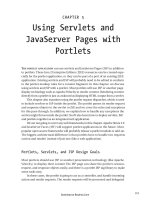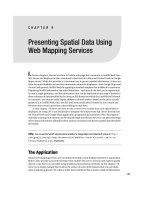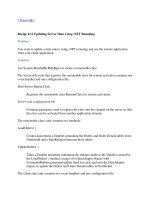Android chapter18a reading XML data Using SAX and W3C Parsers
Bạn đang xem bản rút gọn của tài liệu. Xem và tải ngay bản đầy đủ của tài liệu tại đây (780.17 KB, 27 trang )
Android
Reading XML Data
Using SAX and W3C Parsers
18A
Victor Matos
Cleveland State University
Notes are based on:
Android Developers
XML Data
2
18. Android – Reading XML Files
XML Data
2
What is XML?
• Extensible Markup Language (XML) is a set of rules for encoding
documents in a readable form.
• Similar to HTML but <tagElements> are user-defined.
• It is defined in the XML Specification produced by the W3C.
• XML's design goals emphasize transparency, simplicity, and
transportability over the Internet.
• Example of XML-based languages include: RSS , Atom, SOAP,
and XHTML.
• Several office productivity tools default to XML format for internal data
storage. Example: Microsoft Office, OpenOffice.org, and Apple's iWork.
3
18. Android – Reading XML Files
XML Data
3
How is XML used?
1. XML is used for defining and documenting object classes.
2. For example, an XML document (.xml) might contain a
collection of complex employee elements, such as
<employee id=“…” title=“…” > </employee>
which lexically includes an “id” and “title” attributes.
3. Employee may also hold other inner elements such as
“name”, “country”, “city”, and “zip”.
4. An XML-Data schema (.xsd) can describe such syntax.
XML Data
4
18. Android – Reading XML Files
XML Data
4
How is XML used? – Employee Example
Microsoft
XML Notepad
5
18. Android – Reading XML Files
XML Data
5
Example 1. Employee.xml
Example taken from:
Microsoft XmlNotepad 2007
/>details.aspx?familyid=72d6aa49787d4118b
a5f4f30fe913628&displaylang=en
<?xml version="1.0" encoding="utf8" ?>
<Employees xmlns="http://Employees">
<Employee id="12615" title="Architect">
<! This is a comment >
<Name>
<First>Nancy</First>
<Middle>J.</Middle>
<Last>Davolio</Last>
</Name>
<Street>507 20th Ave. E. Apt. 2A</Street>
<City>Seattle</City>
<Zip>98122</Zip>
<Country>
<Name>U.S.A.</Name>
</Country>
<Office>5/7682</Office>
<Phone>(206) 5559857</Phone>
<Photo>Photo.jpg</Photo>
</Employee>
<Employee>
. . .
</Employee>
</Employees>
Element: Street
Attributes: id, title
<?xml version="1.0" ?>
<xs:schema xmlns:xs=" elementFormDefault="qualified"
attributeFormDefault="unqualified" targetNamespace="http://Employees" xmlns="http://Employees">
<xs:complexType name="Country">
<xs:sequence>
<xs:element name="Name" type="xs:string" default="U.S.A." />
</xs:sequence>
<xs:attribute name="code" type="xs:language">
<xs:annotation>
<xs:documentation>The registered IANA country code of the format xxxx. For example: enus.</xs:documentation>
</xs:annotation>
</xs:attribute>
</xs:complexType>
<xs:simpleType name="City">
<xs:restriction base="xs:string">
<xs:minLength value="1" />
<xs:maxLength value="50" />
</xs:restriction>
</xs:simpleType>
<xs:simpleType name="Zip">
<xs:restriction base="xs:positiveInteger">
<xs:maxInclusive value="99999" />
<xs:minInclusive value="00001" />
</xs:restriction>
</xs:simpleType>
<xs:simpleType name="EmployeeID">
<xs:annotation>
<xs:documentation>The ITG assigned 5 digit employee identification</xs:documentation>
</xs:annotation>
<xs:restriction base="xs:string">
<xs:length value="5" />
</xs:restriction>
</xs:simpleType>
6
18. Android – Reading XML Files
XML Data
6
Example 1. Employee.xsd – Schema Definition (fragment)
Only a fragment. Lines removed
7
18. Android – Reading XML Files
XML Data
7
Example 2. Mapping with KML (fragment)
KML is a file format
used to display
geographic data in an
Earth browser such as
Google Earth, Google
Maps, and Google
Maps for mobile
Reference:
8
18. Android – Reading XML Files
XML Data
8
Example 2. Mapping with KML (View from Google Earth)
Reference:
9
18. Android – Reading XML Files
XML Data
9
Example 2. Mapping with KML & Playing Golf
Club Men Women
Driver 200-230-260 150-175-200
3-wood 180-215-235 125-150-180
2-Hybrid 170-195-210 105-135-170
3-Hybrid 160-180-200 100-125-160
4-iron 150-170-185 90-120-150
5-iron 140-160-170 80-110-140
6-iron 130-150-160 70-100-130
7-iron 120-140-150 65-90-120
8-iron 110-130-140 60-80-110
9-iron 95-115-130 55-70-95
PW 80-105-120 50-60-80
SW 60-80-100 40-50-60
Typical Distances for (Good) Amateur Players
Reference: Cartoon by Lash Leroux available at
10 10
18. Android – Reading XML Files
XML Data
10
Example 2. Mapping with KML (fragment)
<?xml version="1.0" encoding=“utf-8" ?>
<kml xmlns="
<Document>
<gcPlace gcName="Manakiki Golf Course" gcCity="Willoughby Hills" gcState="Ohio" />
<Placemark>
<name par="4" yards="390" >Tee Hole 1</name>
<Point>
<coordinates>81.4324182271957,41.5984273639879,0</coordinates>
</Point>
</Placemark>
<Placemark>
<name>Front of Green Hole 1</name>
<Point>
<coordinates>81.433182656765,41.5955730479591,0</coordinates>
</Point>
</Placemark>
<Placemark>
<name>Middle of Green Hole 1</name>
<Point>
<coordinates>81.4331665635109,41.5954647298964,0</coordinates>
</Point>
</Placemark>
</Document>
</kml>
11
18. Android – Reading XML Files
XML Data
11
Example 2. Reading/Parsing a Resource KML File (code)
• In this example we will read an XML file saved in the /re/xml folder.
The example file contains a set of place-markers around a golf course.
• A SAX (Simple API for XML) XmlPullParser is used to scan the
document using the .next() method and detect the main eventTypes
START_TAG
TEXT
END_TAG
END_DOCUMENT
• When the beginning of a tag is recognized, we use the .getName()
method to grab the tag name.
• We use the method .getText() to extract data after TEXT event.
SAX
Simple API for XML
Reference:
12
18. Android – Reading XML Files
XML Data
12
Example 2. Reading/Parsing a Resource KML File (code)
Attributes from an element can be extracted using the methods:
.getAttributeCount()
.getAttributeName()
.getAttributeValue()
For the example below:
<name par="4" yards="390" >Tee Hole 1</name>
SAX
Simple API for XML
Reference:
Element: “name”
Text: “Tee Hole 1”
Attributes
AttributeName AttributeValue
par 4
yards 390
13
18. Android – Reading XML Files
XML Data
13
Example 2. Reading/Parsing a Resource KML File
Using the XmlPullParser class to generate scanner/parser to traverse an XML document
SAX
Simple API for XML
SAX
Simple API for XML
14
18. Android – Reading XML Files
XML Data
14
Example 2. Reading a Resource KML File (code)
<?xml version="1.0" encoding="utf-8"?>
<LinearLayout xmlns:android="
android:orientation="vertical"
android:layout_width="fill_parent"
android:layout_height="fill_parent">
<Button
android:layout_height="wrap_content"
android:layout_gravity="center"
android:layout_width="wrap_content"
android:text="Read XML data"
android:id="@+id/btnReadXml" />
<ScrollView android:id="@+id/ScrollView01"
android:layout_width="fill_parent"
android:layout_height="wrap_content"
android:layout_weight="2">
<TextView android:id="@+id/txtMsg"
android:layout_width="fill_parent"
android:layout_height="wrap_content"
android:background="#ff0000ff"
android:textStyle="bold"/>
</ScrollView>
</LinearLayout>
SAX
Simple API for XML
15
18. Android – Reading XML Files
XML Data
15
Example 2. Reading a Resource KML File (code)
// demonstrates the reading of XML resource files. In this case
// containing mapping data (kml) holding inner elements as well
// as common <node> text </node> tags.
//
package ucr.xmlreading;
import . . .
public class Main extends Activity {
private TextView txtMsg;
Button btnGoParser;
@Override
public void onCreate(Bundle savedInstanceState) {
super.onCreate(savedInstanceState);
setContentView(R.layout.main);
txtMsg = (TextView) findViewById(R.id.txtMsg);
btnGoParser = (Button)findViewById(R.id.btnReadXml);
btnGoParser.setOnClickListener(new View.OnClickListener() {
@Override
public void onClick(View v) {
btnGoParser.setEnabled(false);
XmlPullParser parser = getResources().getXml(R.xml.manakiki_hole1_v2);
StringBuilder stringBuilder = new StringBuilder();
String nodeText = "";
String nodeName = "“;
16
18. Android – Reading XML Files
XML Data
16
Example 2. Reading a Resource KML File (code)
try {
int eventType = -1;
while (eventType != XmlPullParser.END_DOCUMENT) {
eventType = parser.next();
if(eventType == XmlPullParser.START_DOCUMENT) {
stringBuilder.append("Start document \n");
} else if(eventType == XmlPullParser.END_DOCUMENT) {
stringBuilder.append("End document \n");
} else if(eventType == XmlPullParser.START_TAG) {
nodeName = parser.getName();
stringBuilder.append("Start tag:\t" + parser.getName() + "\n");
innerAttributes(parser, stringBuilder);
} else if(eventType == XmlPullParser.END_TAG) {
stringBuilder.append("End tag: \t" + parser.getName() + "\n");
} else if(eventType == XmlPullParser.TEXT) {
if (nodeName.equals("name")) stringBuilder.append("\n");
nodeText = parser.getText();
stringBuilder.append("Text: \t\t" + parser.getText() + "\n");
tokenizeText(parser, stringBuilder, nodeName);
}
txtMsg.setText(stringBuilder.toString());
}
}catch(Exception e) {
Log.e("<<PARSING>>", e.getMessage());
}
}
});
}//onCreate
SAX
Simple API for XML
17
18. Android – Reading XML Files
XML Data
17
Example 2. Reading a Resource KML File (code)
private void innerAttributes(XmlPullParser parser, StringBuilder stringBuilder) {
// trying to detect inner elements nested around gcData tag
String name = parser.getName();
if (!name.equals("gcPlace")) return;
String gcName = null;
String gcCity = null;
String gcState= null;
// Processing a fragment of the type:
// <gcPlace gcName="Manakiki GC" gcCity="Willoughby" gcState="OH" ></gcPlace>
if((name != null) && name.equals("gcPlace")) {
int size = parser.getAttributeCount();
for(int i = 0; i < size; i++) {
String attrName = parser.getAttributeName(i);
String attrValue = parser.getAttributeValue(i);
if((attrName != null) && attrName.equals("gcName")) {
gcName = attrValue;
} else if ((attrName != null) && attrName.equals("gcCity")) {
gcCity = attrValue;
} else if ((attrName != null) && attrName.equals("gcState")) {
gcState = attrValue;
}
}
if((gcName != null) && (gcCity != null) && (gcState != null) ) {
stringBuilder.append(" <<INNER>> \t:"
+ gcName + ", "
+ gcCity + ", "
+ gcState + "\n");
txtMsg.setText("<<INNER>> \t:" + stringBuilder.toString() + "\n");
}
}
}//innerElements
SAX
Simple API for XML
18
18. Android – Reading XML Files
XML Data
18
Example 2. Reading a Resource KML File (code)
private void tokenizeText(XmlPullParser parser, StringBuilder stringBuilder, String
nodeName){
// interpreting text enclosed in a “coordinates” tag
String text = parser.getText();
if ((text==null) || (!nodeName.equals("coordinates"))) return;
// parsing <coordinates> latitude, longitude, altitude </coordinates>
String [] loc = text.split(",");
text = "<<LOC>> " + nodeName
+ " Lon: " + loc[0] + " Lat: " + loc[1] + "\n";
stringBuilder.append(text);
txtMsg.setText(stringBuilder );
}//tokenizeBuilder
}//Main
SAX
Simple API for XML
19
18. Android – Reading XML Files
XML Data
19
Example 3. Reading XML from the SD card (code)
In this example we read the same XML data of the previous example; however the
file is stored in the SD card.
Rather than stepping through the SAX eventTypes recognized by an XmlPullParser,
a W3C DocumentBuilder parser will be used here.
The XML file is given to the W3C parser to construct an equivalent tree.
Elements from the XML file are represented in the parse-tree as NodeLists. These
ArrayList-like collections are made with the .getElementsByTagName() method.
An individual node from a NodeList could be explored using the methods:
.item(i), .getName() , .getValue() , .getFirstChild() , .getAttributes(),…
Note: The World Wide Web Consortium (W3C.org) is an “international community that develops open standards to ensure the
long-term growth of the Web”.
20
18. Android – Reading XML Files
XML Data
20
Example 3. Reading an XML file from the SD card (code)
<?xml version="1.0" encoding=“utf-8" ?>
<kml xmlns="
<Document>
<gcPlace gcName="Manakiki Golf Course" gcCity="Willoughby Hills" gcState="Ohio" />
<Placemark>
<name par="4" yards="390" >Tee Hole 1</name>
<Point>
<coordinates>81.4324182271957,41.5984273639879,0</coordinates>
</Point>
</Placemark>
<Placemark>
<name>Front of Green Hole 1</name>
<Point>
<coordinates>81.433182656765,41.5955730479591,0</coordinates>
</Point>
</Placemark>
<Placemark>
<name>Middle of Green Hole 1</name>
<Point>
<coordinates>81.4331665635109,41.5954647298964,0</coordinates>
</Point>
</Placemark>
</Document>
</kml>
21
18. Android – Reading XML Files
XML Data
21
Example 3. Reading an XML file from the SD card (code)
<?xml version="1.0" encoding="utf-8"?>
<LinearLayout xmlns:android="
android:layout_width="fill_parent"
android:layout_height="fill_parent"
android:orientation="vertical" android:background="#ff0000ff">
<Button
android:id="@+id/button1"
android:layout_width="106dp"
android:layout_height="wrap_content"
android:layout_gravity="center"
android:text="Go" />
<ScrollView
android:id="@+id/scrollView1"
android:layout_width="match_parent"
android:layout_height="wrap_content"
android:layout_weight="0.62" >
<LinearLayout
android:id="@+id/linearLayout1"
android:layout_width="match_parent"
android:layout_height="match_parent" >
<EditText
android:id="@+id/editText1"
android:layout_width="wrap_content"
android:layout_height="wrap_content"
android:layout_weight="1" >
<requestFocus />
</EditText>
</LinearLayout>
</ScrollView>
</LinearLayout>
package csu.matos;
import . . .
public class ReadingXMLVersion1Activity extends Activity {
Button btnGo;
EditText txtMsg;
XmlPullParser parser;
String elementName;
String attributeName;
String attributeValue;
StringBuilder str;
@Override
public void onConfigurationChanged(Configuration newConfig) {
// needed to avoid re-starting app on orientation changes
super.onConfigurationChanged(newConfig);
}
@Override
public void onCreate(Bundle savedInstanceState) {
super.onCreate(savedInstanceState);
setContentView(R.layout.main);
txtMsg = (EditText) findViewById(R.id.editText1);
22
18. Android – Reading XML Files
XML Data
22
Example 3. Reading an XML file from the SD card (code)
NOTE: You need to modify the Manifest to stop reorientation. Add the
following attributes to the <activity … > element
android:screenOrientation="portrait"
android:configChanges="keyboardHidden|orientation"
btnGo = (Button) findViewById(R.id.button1);
btnGo.setOnClickListener(new OnClickListener() {
@Override
public void onClick(View v) {
txtMsg.setTextSize(10);
useW3cOrgDocumentBuilder(); // see www.w3c.org
}
});
}// onCreate
private void useW3cOrgDocumentBuilder() {
try {
String kmlFile = Environment.getExternalStorageDirectory()
.getPath() + "/manakiki_hole2_v2.kml";
InputStream is = new FileInputStream(kmlFile);
DocumentBuilder docBuilder = DocumentBuilderFactory.newInstance()
.newDocumentBuilder();
Document document = docBuilder.parse(is);
NodeList listNameTag = null;
NodeList listCoordinateTag = null;
if (document == null) {
txtMsg.setText("Big problems with the parser");
return;
}
23
18. Android – Reading XML Files
XML Data
23
Example 3. Reading an XML file from the SD card (code)
24
18. Android – Reading XML Files
XML Data
24
Example 3. Reading an XML file from the SD card (code)
StringBuilder str = new StringBuilder();
// dealing with 'name' tagged elements
listNameTag = document.getElementsByTagName("name");
// showing 'name' tags
for (int i = 0; i < listNameTag.getLength(); i++) {
Node node = listNameTag.item(i);
int size = node.getAttributes().getLength();
String text = node.getTextContent();
str.append("\n " + i + ":- name text > " + text);
// get all attributes of the current ‘name’ element (i-th hole)
for (int j = 0; j < size; j++) {
String attrName = node.getAttributes().item(j).getNodeName();
String attrValue = node.getAttributes().item(j).getNodeValue();
str.append("\n\t attr. info-" + i + "-" + j + ": "
+ attrName + " " + attrValue);
}
}
25
18. Android – Reading XML Files
XML Data
25
Example 3. Reading an XML file from the SD card (code)
// dealing with 'coordinates' tagged elements
listCoordinateTag = document.getElementsByTagName("coordinates");
// showing 'coordinates' tags
for (int i = 0; i < listCoordinateTag.getLength(); i++) {
String coordText = listCoordinateTag.item(i).getFirstChild()
.getNodeValue();
str.append("\n\t " + i + ": " + coordText);
}
txtMsg.setText(str.toString());
} catch (FileNotFoundException e) {
e.printStackTrace();
} catch (ParserConfigurationException e) {
e.printStackTrace();
} catch (SAXException e) {
e.printStackTrace();
} catch (IOException e) {
e.printStackTrace();
}
}// useW3cOrgDocumentBuilder
}// Activity









